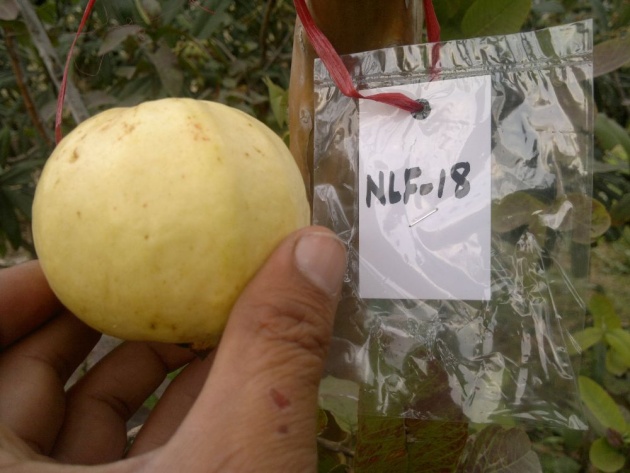Guava (Psidum guajava L.) is an evergreen plant, having round, oval or pear-shaped fruit. The thick rind, white, red or yellow in colour is edible, as is the soft pulp inside, which contains numerous hard and small seeds. Guava fruits are used mostly as a component of juice drinks, as salad or for making jams and jellies. Guavas are very high in vitamin C, containing ten times more than tomatoes.
It has been cultivated in Kohat since ancient times. It is believed to have been grown since 17th century. It is an important fruit giving two crops in a year and is grown in all the provinces of the country.
Kohat is famous for guava production throughout the province. But the propagation of the guava in Kohat is mainly done by sexual means i.e. through seed due to which the quality of the fruit is degrading day by day. There are very vast collections of guava types on farmers’ fields in Kohat where very attractive fruits develop. It is therefore, imperative to collect different types of guava plants on the basis of colour, taste and high yield to study their performance and increase/propagate these plants through asexual means i.e. cutting.
Area ,Production and Yield of Guava in Pakistan and Khyber Pakhtunkhwa
|
|
Area (000 hec) |
Production (000 tonnes) |
Yield (kg ha) |
|
Pakistan |
64 |
546.6 |
8541 |
|
Khyber Pakhtunkhwa |
4.4 |
48.3 |
10977 |
Varieties:
Red Guava and White Guava (Sufeed) are two common varieties grown in Kohat.
Major Insect/Pest:
Oriental fruit fly (Bactrocera dorsalis Diptera)
Mealy bug (Pseudococcus sp. Homoptera)
Guava fruit moths (Argyresthia eugeniella Lepidoptera)
Diseases:
- Dieback
- Brown rot
Post harvest losses: 25-30 % losses (approx)
Causes of Post Harvest Losses: Physiological and Biochemical Aspects
- Poor quality and uneven ripening are due to early harvesting and late harvesting which results in extremely poor shelf life.
- The rate of respiration increases rapidly with ripening. The sudden upsurge in respiration is called the ‘climacteric rise’, which is considered to be the turning point in the life of the fruit. After this the senescence and deterioration of the fruit begin.
Mechanical Injury
Poor handling, unsuitable containers, improper packaging and transportation can easily cause bruising, cutting, breaking, impact wounding and other forms of injury.
Parasitic Diseases
High post-harvest losses are caused by the invasion of fungi, bacteria, insects and other organisms.
Sites of losses
Losses may occur anywhere from the point where the food has been harvested or gathered up to the point of consumption.
Management to reduce Post harvest losses:
Precooling Good temperature management is the most effective way to reduce post-harvest losses and preserve the quality of fruits and vegetables.
Sanitation
Sanitation is of great concern to produce handlers, not only to protect produce against post harvest diseases, but also to protect consumers from food borne illnesses.
Presizing and Storage
For many commodities fruits below a certain size are eliminated manually or mechanically by presizing belt. Undersized fruits are diverted for processing. The sorting process eliminates cull, overripe, misshapen and otherwise defective fruit and separates produce by colour, maturity and ripeness classes.
Grading
Essentially all fruits and vegetables sold in modern markets are graded and sized into two or more grades according to trade standards.
Waxing
Food grade waxes are commonly applied to replace some of the natural waxes removed in the washing and cleaning operations to reduce water loss and to improve appearance.
Packaging
Packaging of fresh fruits and vegetables has a great significance in reducing the wastage. Packaging provides protection from physical damage during storage, transportation and marketing.




